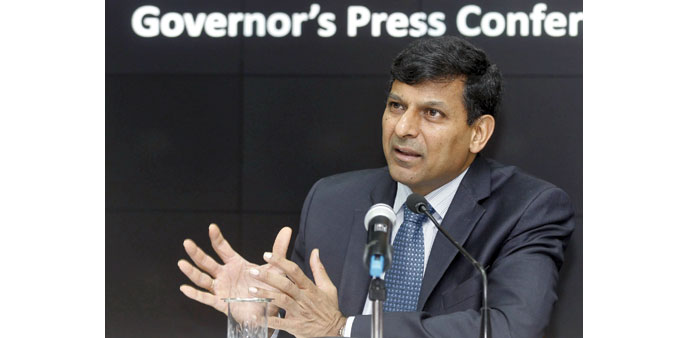Reserve Bank of India governor Raghuram Rajan speaks during a news conference in Mumbai. The RBI said yesterday it would soon announce a new methodology that will force lenders to set lending rates based on their cost of funding, taking away some of their freedom in setting rates.
Reuters
Mumbai
India’s central bank kept its key lending rate unchanged yesterday, leaving the door open for more easing but making that dependent on meeting a challenging inflation target for 2017.
At its last meeting in September, the Reserve Bank of India (RBI) slashed the repo rate by 50 basis points to 6.75% to boost growth.
Yesterday’s hold had been widely expected, after consumer inflation picked up to a four-month high of 5% in October and as emerging markets brace for a hike in US interest rates.
All 45 respondents in a Reuters poll last week expected the RBI to hold the repo rate.
RBI governor Raghuram Rajan noted weak rural and global demand was holding back economic growth, while highlighting pockets of softness in sectors such as construction.
But he said the focus of monetary policy would shift towards achieving consumer inflation of 5% by March 2017, a target analysts say will be challenging, even as he noted risks to inflation remained “slightly to the downside” by the coming March.
The RBI “will use the space for further accommodation, when available, while keeping the economy anchored to the projected disinflation path that should take inflation down to 5% by March 2017,” Rajan said in his statement.
Achieving the RBI’s target of 6% inflation in January should not be a problem. But achieving Rajan’s March 2017 objective may prove more difficult for a country that less than two years ago suffered double-digit inflation. A recent pay hike for government employees and potential food price shocks are causing renewed concern about inflation.
Meanwhile, a prolonged slump in commodity prices has pushed down consumer prices, but a more sustainable fall would depend on the government continuing to keep a lid on spending and pass reform measures such as a national goods and service tax.
The RBI’s next policy review is on February 2, before the government usually releases its budget for the coming financial year.
Abheek Barua, chief economist of HDFC Bank in New Delhi, said he expects no change in the repo rate until after the budget, “if at all”.
“The risks point to a very cautious approach to accommodation,” he said. “The rate cuts have been front-loaded.”
The RBI has lowered the repo rate by 125 basis points this year, including the larger-than-expected 50 bps in September.
Easing inflation has let the RBI focus on supporting economic growth. Data on Monday showed the economy grew 7.4% in the September quarter, faster than China, but below the government’s goal of 8.0 to 8.5% annual growth.
The RBI yesterday reiterated its projection the economy will grow 7.4% in the year ending March 2016.
However, Rajan has been frustrated by banks’ slow transmissions of the RBI rate cuts, noting on Tuesday that lending rates had only fallen by a median of 60 basis point.
The RBI said it would soon announce a new methodology that will force lenders to set lending rates based on their cost of funding, taking away some of their freedom in setting rates.
“There’s room building up for banks to transmit more. It’s a matter of time,” Rajan said in a news conference.
Meanwhile, the Federal Reserve is widely expected to raise US rates in December for the first time in nearly a decade.
Although India has outperformed other emerging markets over the past two years, the rupee fell to a two-year low last week and was the worst performer in emerging in Asia in November, as foreign investors sold $1.5bn in bonds and stocks.



